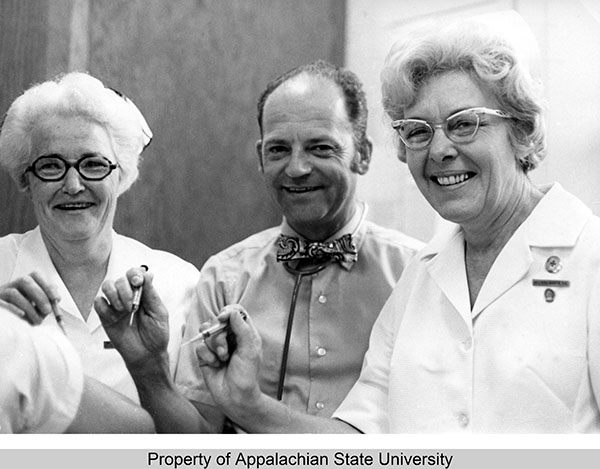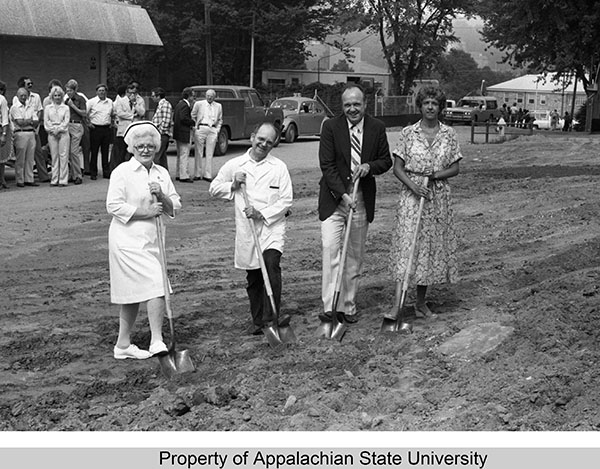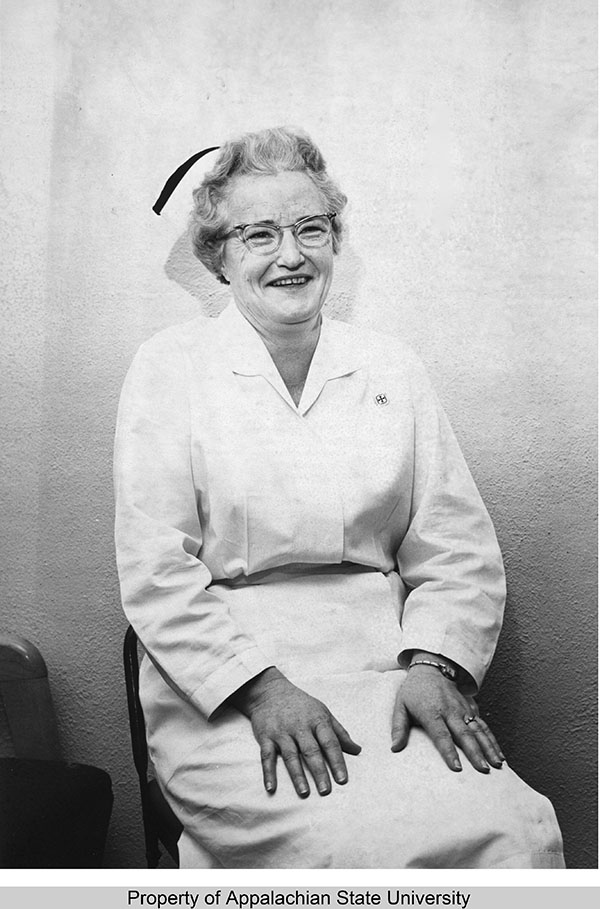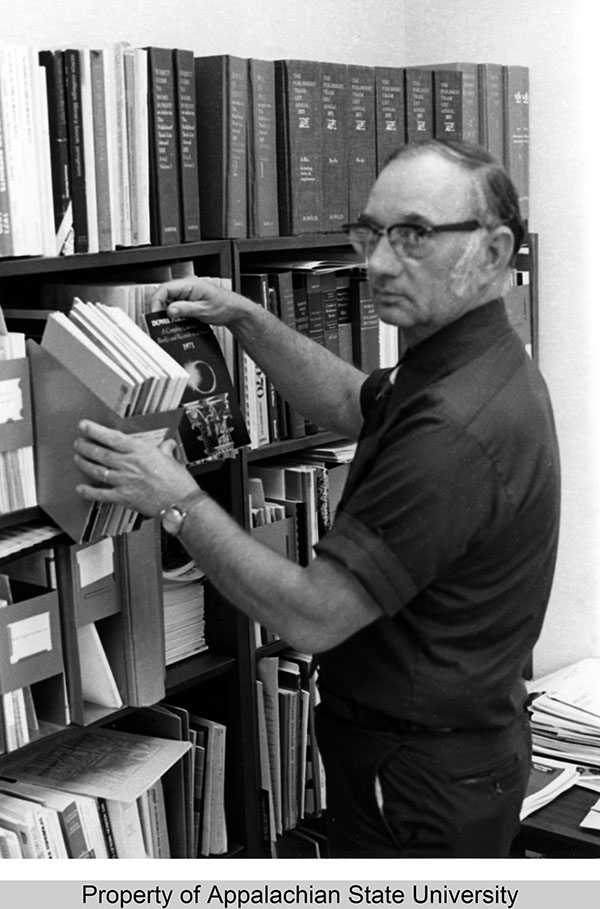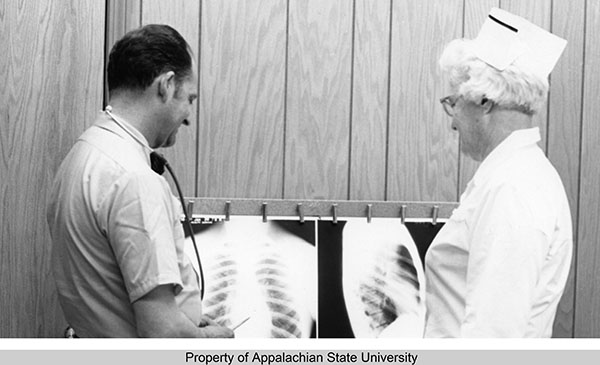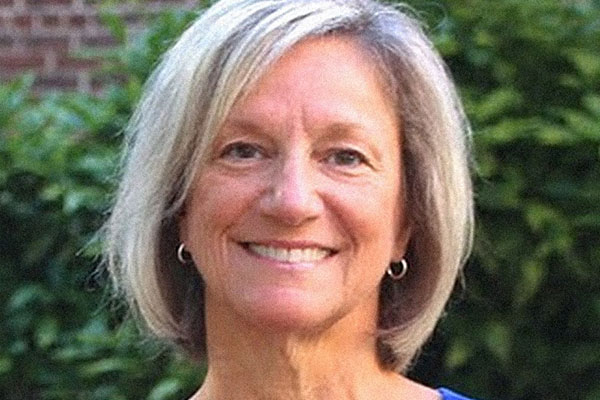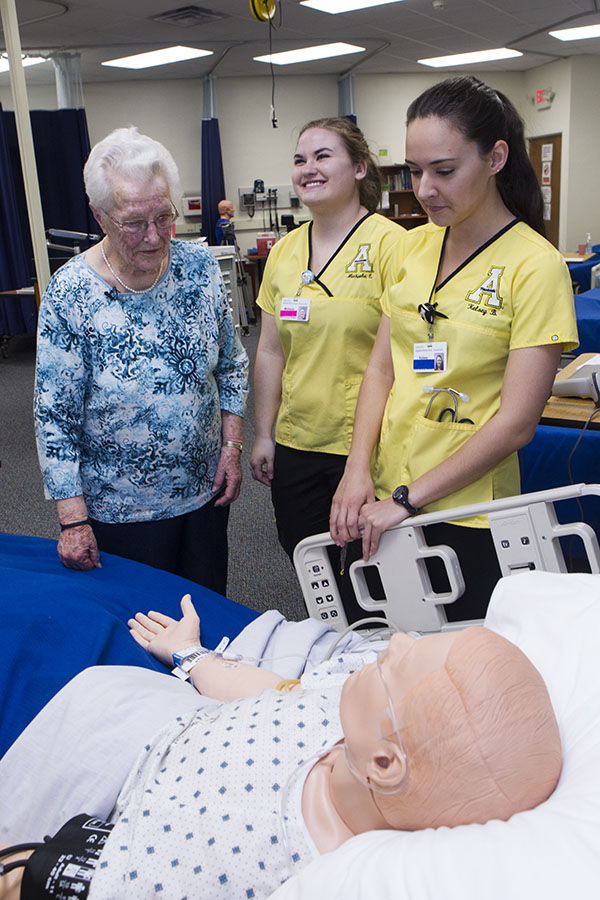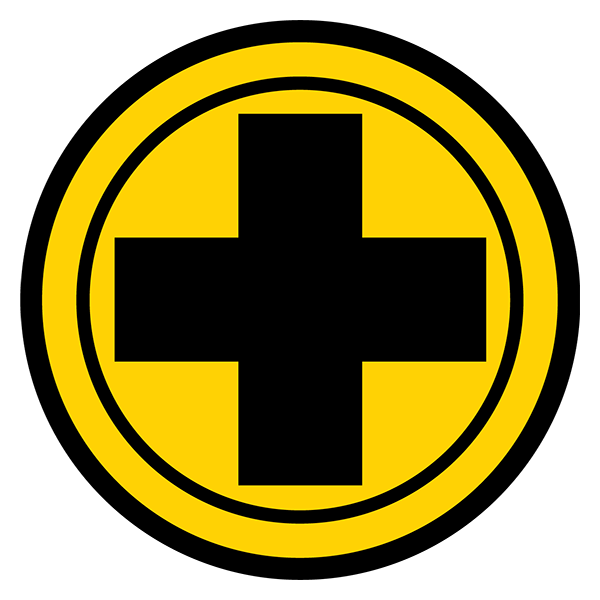Editor’s Note: The author researches North Carolina nursing history and collects oral histories of older nurses. She is also an Appalachian alumna, having earned a master’s degree in education in 1989.
On a crisp, fall day in September 1949, Mrs. Mary Stevenson Shook, R.N., walked into her office in what was to be the student infirmary in White Hall on the Appalachian State Teachers College campus. She found two basement rooms separated by a half bath located on the basement floor of the dormitory, a single bed without linens, exposed water pipes and heating ducts, no supplies or equipment and no telephone. In addition, she had no allotted budget.
Then Nurse Shook heard a mouse. Demonstrating her “can-do” attitude, she promptly walked over to the Administration Building and told ASTC’s business manager, Bernard Dougherty, nephew of one of the college founders, she was “not going to work with rats.”
Nurse Mary S. Shook talks about her 40-year career healing and nurturing Appalachian State University students.
Her third stop that day was the local drugstore, where she bought some aspirin and a thermometer so she could start taking care of students. Relying on her ingenuity, spunk and determination, it was not long before Appalachian State Teachers College had a functioning student health program where Shook made a lifelong commitment to the health and well-being of Appalachian students, faculty and staff.
Appalachian’s first health care provider
Mary Stevenson (Shook) was born Dec. 10, 1918, near Taylorsville in North Carolina’s Alexander County at the foot of the Blue Ridge Mountains. Desiring to help others, she chose nursing as her career. The young woman followed her older sister, Lucille, into the Grace Hospital School of Nursing at Lees-McRae College in nearby Banner Elk. After graduating from the arduous program in 1941, Stevenson accepted a job as a floor nurse and eventually became the nursing director of the operating room at Grace Hospital.
In order to excel in her new position, Stevenson soon completed advanced training in Operating Room Technique and Management at the University of Pennsylvania. She enjoyed her work in the operating room and acquired a reputation as a caring and skilled nursing supervisor. When a severe polio epidemic hit Western North Carolina in 1944, a summer camp near Hickory was converted into the Emergency Polio Hospital. “Every week we would work straight through in the operating room and then go to Hickory to relieve the nurses at the polio hospital. We just had to help each other,” she recalled.
Major changes occurred for her in 1945 when Stevenson married Zeb Shook, who would become the Appalachian State Teachers College acquisitions librarian. The couple moved to Boone, where she began her career in student health. A new accreditation rule mandating health services on campuses spurred the administrators at ASTC to hire their first nurse. Shook was the only health care professional employed on the campus from 1949 until 1952, when Nina Martin, R.N., filled in for Shook’s first maternity leave. For many years, Shook singularly provided all the counseling services and health education on campus in addition to caring for physical health needs. The first physician hired by ASTC, Dr. Evan Ashby, arrived in 1965.
From fevers to sex education
Out of her small basement office in White Hall, then located across from the school cafeteria, Shook took care of everything from fevers to sex education. Although considered a faculty member, she had no job description, was on call 24/7, and took care of anyone and everyone on campus and in the community who needed her help. Her presence on campus was ubiquitous; she taught numerous health lessons to ASTC and Appalachian High School students and provided care at sporting and other campus events. Monday mornings in the fall were reserved for “football clinic,” when she would take care of players injured in weekend games.
Dressed in her full white uniform and cap, she often accompanied the college’s founder, Dr. B.B. Dougherty, on official travel. She even gave B-12 and allergy injections to people who vacationed in Watauga County in the summer months. In addition to her nursing work, Shook found time to sponsor the campus YWCA with another faculty member and worked with the Presbyterian student group on campus. Her daughters remember her bringing many students who were suffering from homesickness or needed some special attention into their home.
Before the arrival of a campus physician when a student required specialized care, she grabbed whomever she could find to help “load [the patient] into ‘Old Brown’,” the infirmary’s aged, brown station wagon, and take them to a nearby doctor. Local physicians, Drs. Len Hagaman, J.B. Hagaman, Henry Perry Sr., Henry Perry Jr., Bill Smith and Hadley Wilson, dispensed care and counsel to the campus community whenever Shook asked.
When a flu epidemic hit the campus a couple of years after she arrived, 3,000 out of the 4,000 students on campus fell ill. The cafeteria employees made hot soups and fruit juice available to the afflicted patients. Dormitory “house mothers” cared for the sick, but when fevers reached over 103 degrees for 12 hours, parents were called to pick up their children because there were not enough beds or personnel on campus to handle the epidemic. Shook was stretched thin checking on ailing students across campus.
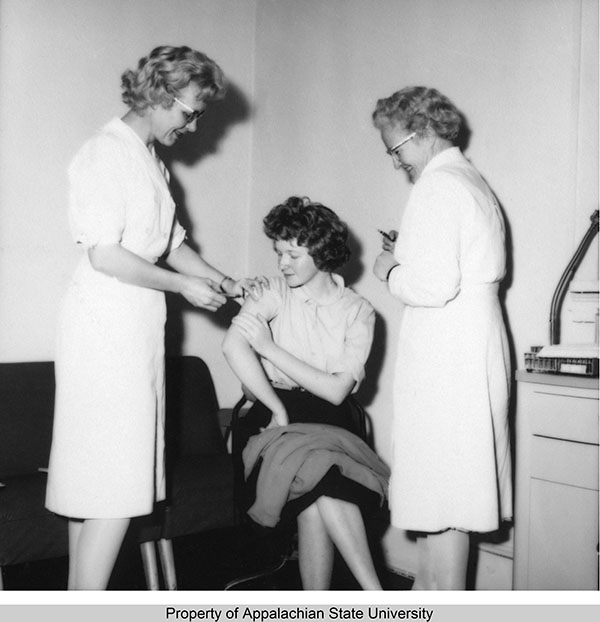
Appalachian’s Health Services opened in 1949 with the hiring of Nurse Mary S. Shook, right, who treated minor injuries and illnesses until her retirement in 1983. By 1968, Health Services was located in Hagaman Hall, since demolished, and included a full-time physician and six registered nurses; offered X-ray services, outpatient treatment of minor injuries and illnesses, and inpatient care; and included two wards of six beds each for males and females. Health Services moved to the Miles Annas Student Services Building in 1981.
Help, in the form of more nurses, arrived in 1952. When Shook was nine months pregnant with her first daughter, Tanya, she was called to a student’s room around midnight to adjust bandaging on the student’s sprained ankle. She took care of the student and then gave birth to her daughter four hours later. Nurse Martin was hired to fill in for Shook for a three-month maternity leave, but after eight weeks, she called Shook pleading with her to return to her duties. Soon, Martin was employed as a day nurse in the infirmary. Over time, early infirmary nurses included Lucille Hovis, Merle Vick, Pat Light, Issa Saylors and Sandy Hagler. Eventually, Inez Williams joined the team as a night nurse. While Shook was pregnant with her second daughter, Myra, Appalachian nurses successfully battled another flu epidemic in 1957. As vaccines developed in the 1950s to prevent polio and the flu, Shook and her team subsequently immunized thousands of students, faculty and staff against these diseases. Over time, as more nurses and physicians were added to the Student Health Services staff in the 1960s and 1970s, Shook continued to work with patients while taking on an administrative position at the infirmary.
A leader in her profession
In addition to her on-campus activities, Shook became a founding member of the Student Health Association of North Carolina and an active member of the Southern College Health Association. She attended annual meetings around the state and the Southeast, getting to know other student health professionals and bringing new ideas back to the Appalachian campus. Shook was elected president of the Southern College Health Association in the early 1960s, the first nurse and the first woman to hold that office. During her tenure as president, she worked ardently to increase the membership of the organization since many college health services around the South had yet to join. While doing so, Shook made life-long friends whom she would bring to Appalachian. Colleagues from institutions like Duke University and Clemson University came to know the campus and Boone area well.
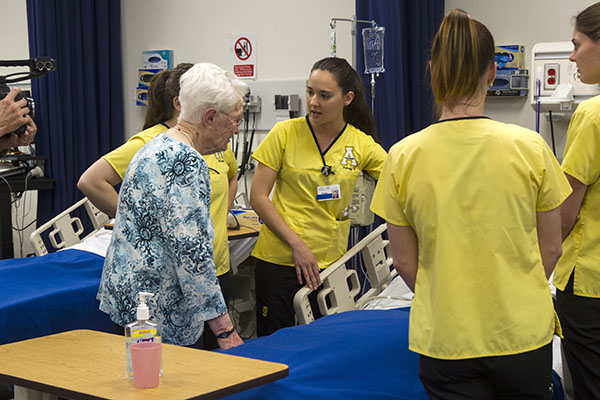
Appalachian began offering its first nursing degree program, the RN-BSN program, in 2006. Today the Department of Nursing is accredited by the Commission on Collegiate Nursing Education (CCNE) and also offers a pre-licensure Bachelor of Science in Nursing (BSN) program and a Master of Science in Nursing (MSN) program. It serves about 650 students.
Shook has received numerous honors and awards. The 1955 Rhododendron, the college yearbook, was dedicated to her, and she received an Outstanding Service Award from the university in 1982. She was instrumental in designing the current Student Health Services building, and upon her retirement from Appalachian State University in 1983, it was named in her honor. In 1984, the National College Health Association conferred the Ollie B. Moten award on Shook for the culmination of a lifetime of service. Gov. James Hunt bestowed the Governor’s Award for Outstanding Service to North Carolina on her in 1982. She became a Distinguished Fellow in the American College Health Association in 1982 and was inducted as an honorary member into Delta Kappa Gamma, a national education sorority.
Today Shook is a spry 97-year-old who treasures her 63-year marriage to Zeb, who passed away in 2008. Still recognized anywhere she goes for administering flu shots and caring for sick students during her 40 years at Appalachian, she lives alone near campus and takes pleasure in her children, grandchildren and other family members. She remains an active member of First Presbyterian Church.
Shook looks back fondly on the people she helped and the friends she made at Appalachian State University. Over her long career, Nurse Shook left an indelible mark on the Appalachian Community.
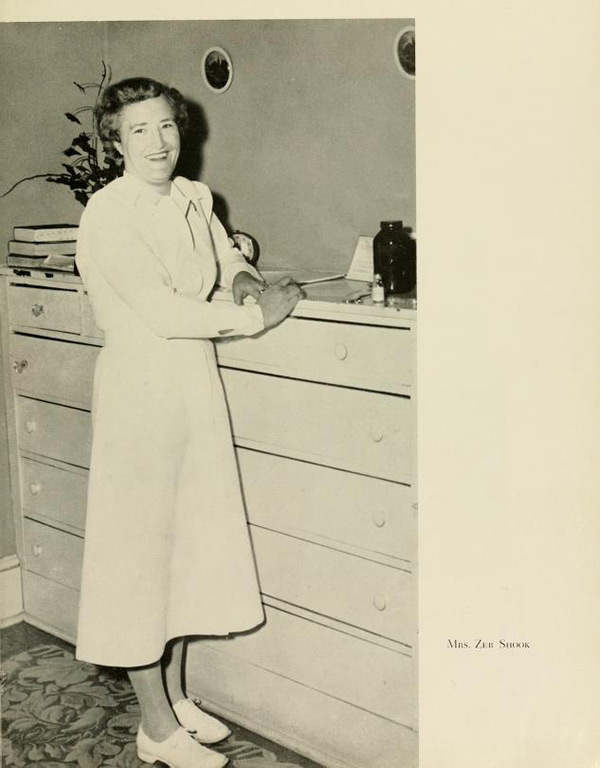

What do you think?
Share your feedback on this story.

